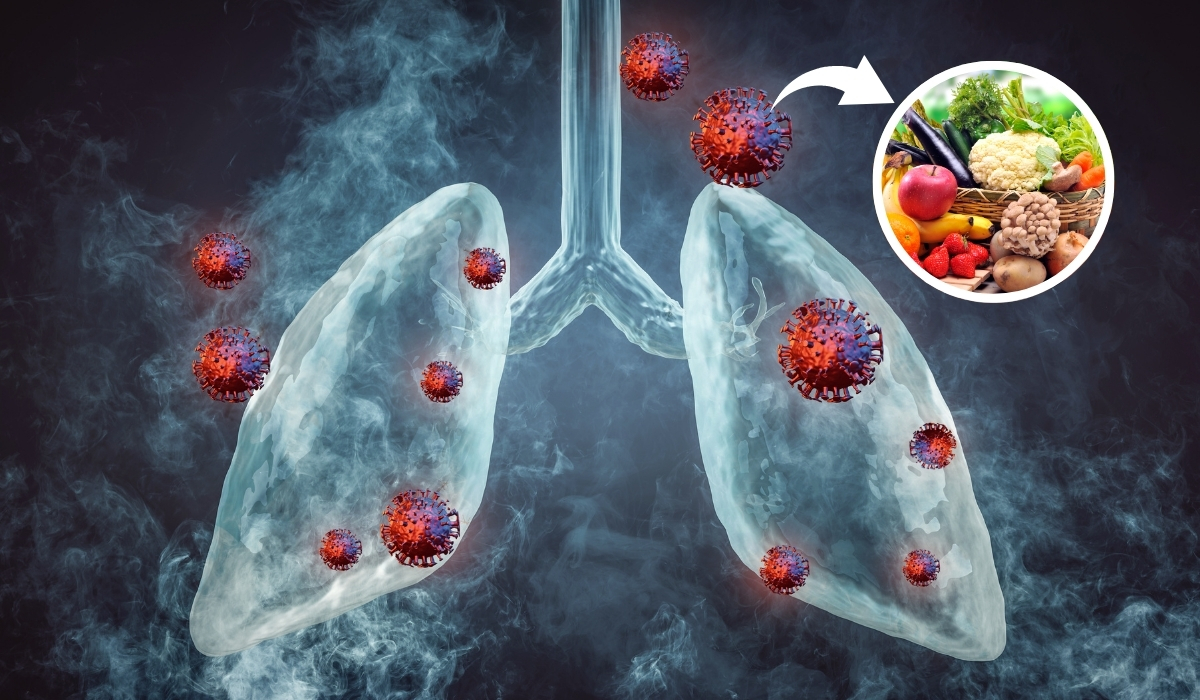
Can Eating More Vegetables and Fruits Lower Lung Cancer Risk? The Truth from a 7-Year Study on 61,000+ Men
by Amiya Nandy in Health & Wellness, Wellness Tips on July 23, 2025The fear of lung cancer risk is no more expressed only through the arena of smokers, though it is an open-ended question dependent on who has an anxiety about a healthier future isn’t it? Furthermore, in addition to the fact that the most crucial single factor in the development of lung cancer is using tobacco, a substantial part of the scientific community is for the idea that the role of diet in the prevention of the disease needs far more attention and the problem differs in an over-complicated manner.
According to a study published in the Chinese Journal of Preventive Medicine and a study of 61,000 men in China or a 7-year long length of time, it has been found that some facts are not only incredible but also show a very high level of optimism.
Multinational study participants, operating under the auspice of PMID: 23368913, assert that specific fruits, vegetables, and vitamins can be highly effective in reducing lung cancer risk, even in smokers.
Now, let us head down the findings and study how they could have a direct impact on your everyday diet.
Summarized Study Parameters
- Study: Shanghai Men’s Health Study
- Period: 2002-2009
- Subjects: 61,491 adult Chinese men
- Place: Shanghai, China
- Cancers: 359 lung cancer cases were diagnosed during the follow-up period
- Objective: Relation of the consumption of fruits, vegetables, and vitamins to the appearance of lung cancer
Just to clarify that it wasn’t just some little trial, made here and there, without any system. I mean, it is about the people who were under observation during a certain time.
In other words, it was a population-based, prospective cohort study, which is the best evidence in nutrition research that can be found in large numbers of people over time.
Fighting with the way people answer facetoface dietary surveys is the only way to succeed? The truth is, the method used in this study was based on validated food frequency questionnaires.
Key Findings That Matter
The data revealed clear associations between dietary patterns and lung cancer risk. But it wasn’t just about eating “more fruits and veggies.” Certain types mattered more.
Here are the top protective foods and nutrients identified:
| Food/Nutrient | Lung Cancer Risk Reduction (Highest vs. Lowest Quartile) |
|---|---|
| Green leafy vegetables | ↓ 28% (HR 0.72) |
| β-carotene-rich vegetables | ↓ 31% (HR 0.69) |
| Watermelon | ↓ 35% (HR 0.65) |
| Vitamin A | ↓ 37% (HR 0.63) |
| Total Carotenoids | ↓ 36% (HR 0.64) |
✅ The study concluded that the consumption of general fruits and vegetables was not significantly fruitful unless the foods were high in carotenoids or vitamin A.
How These Nutrients Support the Defence of Your Lungs
The foods that were more protective were a variety but they all shared common characteristics, from carotenoids to antioxidants.
What are carotenoids?
Carotenoids are pigments found in plants that are the cause of the red, orange, and yellow colors in many fruits and vegetables. Nevertheless, they are more than just beautiful—they also have substantial positive effects:
- Combat oxidative stress
- Scavenge free radicals
- Reduce risk of DNA damage
- Facilitate normal cell signaling
- Hinder tumor development
The most important carotenoids are β-carotene, lutein, and zeaxanthin, which are responsible for lung, eye, and immune health.
The Best Foods High in Carotenoids According to the Research
It was not just vegetables or fruits in general that the researchers took into account this time. They have looked at more specific groups of fruits and vegetables, which have shown statistical safety in reducing lung cancer risk.
1. Leafy Green Vegetables
Examples: Spinach, bok choy, Chinese mustard greens
- Vitamin A and antioxidants have a high content in them
- There are flavonoids in them which neutralize carcinogens
2. β-Carotene Vegetables
Examples: Carrots, sweet potatoes, pumpkin
- Those are sources of provitamin A which can be formed into the active vitamin A
- They are particularly beneficial to the immune system and the lungs resistant to harm
3. Watermelon
- Surprisingly, the study found the fruit to be a very
- rich source in the reduction of risk.
- Is a good source of lycopene and vitamin C
- Helps control inflammation in the airways
- Necessary for the maintenance of the integrity of the epithelial tissue which forms the major protective barrier of the lungs
- It adds thickness to the mucus lining of the airways that
What About Smokers?
The study has demonstrated the increased relevance of the findings for smokers.
Out of the 359 lung cancer cases recorded:
- 68.8% were current smokers
Nevertheless, in the face of the high baseline risk of smokers, individuals who had high intakes of protective foods exhibited a sharp decrease in their incidence rates of cancer. So, the possibility that an appropriate diet may cover certain levels of protection—even against very strong external factors like tobacco—is not something to ignore.
Even if giving up smoking is the most powerful way to avoid cancer, the findings of this study indicate that dietary intervention could still be influential.
What Didn’t Work?
It is worth mentioning that not all fruits and vegetables were equally effective in risk reduction.
- Total fruit intake had somewhat of a protective effect, but the results were barely statistically significant.
- Folate and vitamin C intake had no significant relation.
- The consumption of the general type of vegetables, which were not considered for carotenoid content, showed minor connections.
This underlines not only the necessity to extend the recommendation “eat your veggies” but also to look at the kinds of vegetables and their nutrient density in isolation.
A Deeper Look: How the Data Was Measured
The research team employed the multivariate Cox regression analysis method, which is known to take into account different risk factors such as:
- Smoking status
- Age
- Income
- Physical activity
- Alcohol consumption
By doing this, the researchers were able to examine only the impact of diet on lung cancer risk and sustainability with each conclusion using confidence intervals (CI) and hazard ratios (HR) as sources of support.
For instance, a HR of 0.63 for the intake of vitamin A denotes that male consumers who belong to the top intake category of the substance have a risk that is 37% lower than that of the lower intake group.
The Role of Diet in Epigenetics
This study provides fresh proof of epigenetics theory by outlining research showing how food-related environment factors influence the behavior of genes, i.e., it is the science of how a gene is impacted by the environment.
Some of the functions of carotenoids and vitamin A include:
- They cause irregular cells to die via a programmed process
- They block the formation of new blood vessels by tumors via the process of blood vessels formation in tumors (angiogenesis)
- They attack genes that can cause tumors
The message here is your food has the power to sway your genes’ activities way beyond mere nourishment. In other words, you play with your genes and thus can both turn some which were dormant “on” and vice versa.
What This Means for You
The main pragmatic fact here is that diet really matters. And then, the interesting news is not the long-term ones only, they evoke changes as soon as in your next meal.
✅ If you smoke:
- Go for vegetables such as kale, carrots, and watermelon
- Consume food rich in vitamin A and carotenoids to cleanse the body from within
- Start to eliminate processed and fried foods
✅ If you don’t smoke:
- The function of these same foods is not only to safeguard against secondhand smoke but also to protect you from air pollutants and the oxidative stress you face every day
- Make a habit of eating in a way that fosters lung health
Conclusion
The study on Men’s Health in Shanghai is a rare occurrence, since it is data collected directly from humans in their natural setting over a long stretch of time. The outcome is unequivocally clear—
By consuming these vitamins, the non-death risk of lung cancer will be substantially lower, and it is even more so, in the group of people that are most likely to get high from smoking when they do it consistently over a long period.
One need not have a perfect diet. But putting a few nutrient-dense foods into your meal every day might be the quiet, steady transformation you need on your health journey at your cellular level.





